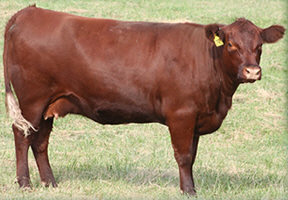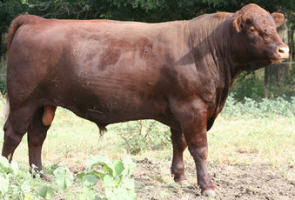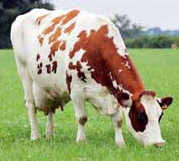



Red Poll
History
Red Poll cattle were developed as a dual-purpose breed in their native counties in England.Breeders sought a type that would fatten readily rather than be of extreme size. A good milk flow was also considered important in selecting breeding stock in the development of the breed in its native land.
The counties of Suffolk and Norfolk in England are the original homes of the Red Poll. These counties, which lie in a low rather marshy part of England, border the North Sea and have soil that is generally lacking in fertility. The first general agricultural records of England record a great interest in dairy, particularly in Suffolk County. However, the farmers did not specialise in dairy animals but preferred cattle with a combination of milk production and high quality carcasses.
 Photo courtesy of Lazy S Farm, www.lazysredpoll.com |
In discussing the cattle of Suffolk in 1794, Rev. Arthur Young, in his book The General View of Agriculture of the County of Norfolk, reported:
This breed is universally polled, that is without horns; the size small, few rise when fat to above fifty stones (fourteen pounds)... If I were to describe the points of certain individuals... a clean throat with little dewlap; a thin clean snake head; thin legs; a very large carcase; ribs tolerably springing from the centre of the back but with a heavy belley; backbone ridged; chine thin and hollow; loin narrow; udder large, loose and creased when empty; milk-veins remarkably large, and rising in knotted puffs to the eye... many of these beasts will fatten remarkably well; the flesh of a fine quality; and in that state will feel well enough to satisfy the touch of skillful butchers. The best milkers I have known, have either been red, brindle, or yellowish cream coloured... the quality of milk is very considerable indeed.
The cattle of Norfolk were described in 1782 by Marshall (as quoted in the Red Polled Herd Book, vol 1, American ed., 1891) as:
a small, hardy, thriving race; fattening as freely and finishing as highly at three years old as cattle in general do at four or five. They are small boned, short legged, round barrelled, well-loined, thin-thighed, clean chapped; the head, in general, fine, and the horns clean, middle sized and bent forward; the favorite colour a blood-red with a white mottled face... and if the London butchers be judges of beef, there are no better beasts sent to Smithfield market. The two qualifications, namely the superior quality of their flesh, and their fattening freely at an early age, do away with every solid objection to their size and form.
It is not definitely known when the two breeds were first crossed, or what infusions of blood may have been from other breeds. Galloway Cattle and Devons were brought into the area, and, no doubt, some of this breeding found its way into what later was called the Red Polled Breed.
The Red Poll In America
G.P Taber of New York State started importing Red Polled cattle in 1873. His first importation consisted of a bull and three heifers; two years later, he imported four more cows; in 1882 he brought over three bulls and twenty-three additional heifers. In 1882, Messrs. Mead and Kimball, Randolph, Vermont, imported a bull and ten females. Importation was a thriving business for a few years but after 1902 practically no more Red Polls were brought over. The breed was established in the United States on only about 300 head that were brought in from Britain. The breed spread from the United States into Canada.Current selection criteria on Red Poll in the United States is primarily for beef production.
Characteristics
Red Poll cattle are a deep red colour with good eye and udder pigmentation (avoids sunburn)and naturally polled. They are medium size (similar to all British breeds) with strong legs and good walking ability. Photo courtesy of Lazy S Farm, www.lazysredpoll.com |
The beef is fine grained and has won the competitions in Australia for the most tasty and tender beef as judged by a consumer panel. Red Polls are still milked in England - the milk has a small fat globule so is the next best to goat's milk if people are allergic to cow's milk.
Statistics
Comparative
Distribution
Due to Red Polls good qualities the breed has been exported from the UK all over the world including the USA, Canada, New Zealand, South Africa and Europe.References (the above information was cited from the following sites)
www.ansi.okstate.edu
www.redpoll.org
www.redpollcattle.co.nz
www.lazysredpoll.com


